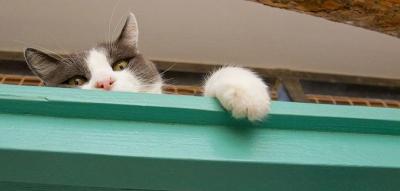
Cat Declawing: Effects and Alternatives
Cat declawing is still routinely performed in the United States, even though it is illegal or considered inhumane in many other countries around the world. Most people decide to have their cats declawed as a matter of convenience to protect their furniture from cat scratching or to guard against injury to themselves and family members. However, declawing is a painful procedure for cats that can having lasting negative effects.
What does declawing do to a cat?
Many people don’t realize the pain that the cat declawing surgery can cause. Declawing cats involves the amputation of each toe at the first joint. In humans, it would be equivalent to cutting off the tip of every finger at the first knuckle — very painful indeed. If performed on a human, this operation would be considered a mutilation. It is as unethical as tail docking and ear clipping in dogs.
People who declaw their cats also might not be aware that the surgery can cause more problems than it solves. Cats deprived of their front claws can develop an aversion to the litter box. Their paws remain sensitive from the surgery, so they avoid scratching in their litter and might begin eliminating around the house instead.
Declawing also leaves cats without one of their primary defense mechanisms, and it impairs their balance and ability to climb. Many declawed cats suffer from joint stiffness. And in certain cats, it can leave psychological scars that translate into behavioral problems.
Home starts with you
Declawing is essentially done for the convenience of humans — to the detriment of the cat. You are working against rather than with your kitty if you force them to endure needless pain and put them at risk for developing negative side effects to the surgery.
What are alternatives to cat declawing?
If you want to protect from scratching, there are humane alternatives to cat declawing. First, remember that cats scratch things for various reasons — to slough off the husks of dead claws, to mark their territory, and to stretch their bodies. It’s a completely natural behavior.
So give your cat an appropriate place to scratch: a scratching post. You can encourage your kitty to use the scratching post by rubbing or spraying it with catnip. There are many different kinds of scratching posts (both vertical and horizontal), so you might want to try several different kinds to find the one your cat prefers.
There are also several different products available at pet supply stores to discourage your cat from scratching the furniture. You can apply clear sticky strips called Sticky Paws to your furniture or spray the furniture with a smell (like citrus) that cats don’t like.
Other things that might help: Keep your cat’s claws trimmed or apply soft plastic caps (called Soft Paws) to your cat’s claws.
If you would like more information about declawing and alternatives to it, visit The Paw Project.
